
CASC exhibition area at the 14th China International Aviation and Aerospace Exhibition in Zhuhai, South China's Guangdong Province Photo: Courtesy of CASC
As China plans to realize a manned moon landing before 2030, the country will attempt to build a moon-based scientific research station, in a bid to carry out long-term, systematic lunar research and verify relevant technology, Zhang Hailian, deputy chief engineer with the China Manned Space Agency (CMSA), revealed on Wednesday.
Zhang made the remarks while outlining the China's primary manned moon landing plan in a keynote speech at the opening event of the Nineth China (International) Commercial Aerospace Forum (9th CCAF) in Wuhan, Central China's Hubei Province on Wednesday.
China will attempt to use two launch vehicles to send a moon surface lander and manned spacecraft into lunar orbit before they carry out rendezvous and docking with each other. Following this maneuver, taikonauts onboard the manned spacecraft will enter the lander, Zhang said.
Taikonauts will carry out scientific exploration and sample collecting after they descend to the moon's surface using the lander. After completing all preset missions, they will engage the lander to ascend and dock with the manned spacecraft waiting in the lunar orbit, he said.
Then taikonauts will take the lunar samples and return to Earth in the manned spacecraft.
Currently, China is working on the research and development of the Long March-10 carrier rocket, a new-generation manned spacecraft, lunar surface lander as well as the lunar manned rover that could support two taikonauts, for the mission, the Global Times has learned from developers.




